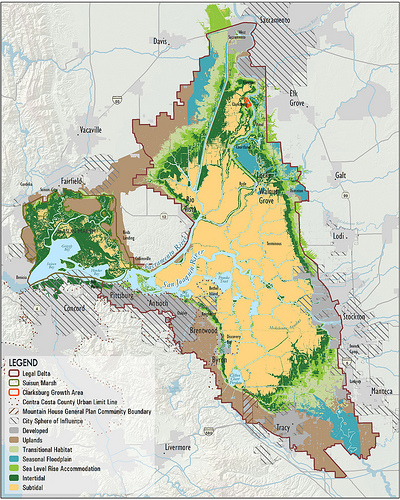Matt Weiser at the Sacramento Bee offered up a fascinating framework in a piece last Sunday for thinking about California’s $23 billion (and counting) proposal to reshape the way water moves in and through the largest estuary on the western coast of North America:
[A]s the process now stands California voters will have no formal say in approving the plan. Nor will the state Legislature.
State officials believe they already have the statutory authority, under laws passed in 1933 and 1960, to do this project.

Sacramento-San Joaquin Delta
So we are left, as California slogs forward with this staggeringly important public policy decision, with a strange situation. Under the law, state officials believe the already have the necessary statutory authority, essentially, to remove large quantities of water from the Sacramento-San Joaquin Delta, shipping the water south to farms and cities in the Central Valley and Southern California. The officials Weiser is quoting believe the statutory authority already exists to build two giant tunnels beneath the delta to accomplish these ends. Again, Weiser:
[A]s now laid out, the only real veto power over the project lies with state and federal wildlife agencies: the California Department of Fish and Wildlife, the U.S. Fish and Wildlife Service and the National Marine Fisheries Service. These agencies are responsible for ensuring that the plan satisfies state and federal endangered species acts.
Thus we are in this strange statutory never-never land where what we’re really talking about here with the BDCP is not the development of giant water-moving infrastructure to ensure reliable supplies for water users to the south. Rather, we’re talking about the development of a “Habitat Conservation Plan” to ensure that existing state and federal statutory authorities to move water do not, in their execution, harm endangered species. If, to meet the requirements of that HCP, we have to build giant tunnels to move water, so be it.
I’ve written before about this fascinating conundrum. One could imagine an endangered species management process that concludes that the best habitat conservation approach would be to not move so much water. And yet here we are.
So let’s play alternate histories. What might a California water policy development process look like that was intended to deal with the problems of the delta, but wasn’t carried out within the framework of state and federal endangered species laws. My hunch is we’d still be talking about building a couple of big tunnels?
